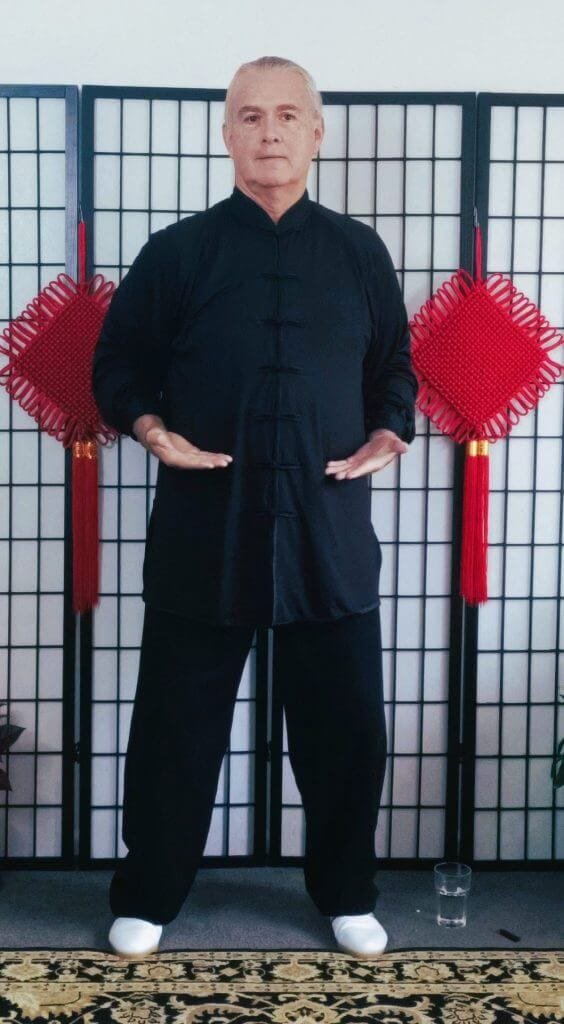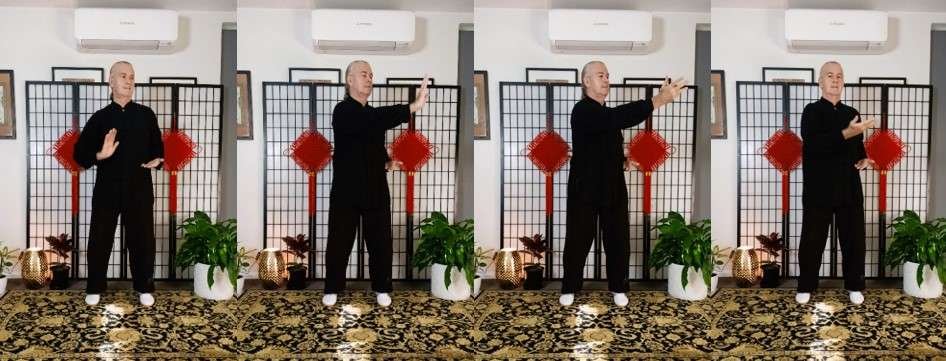We completed the last movement, Gaze at the Moon, with the hands returning to just in front of the Dantian with palms facing up.

To commence Push the Mountain, bring the hands back to the body such that the wrists rest on the bony protrusions of the pelvic girdle. They should rest there naturally. This is the starting position for the hands. See the picture above.
Now, with the right hand, turn it from palm facing up, to palm facing outward such that the fingers are pointing vertically to the ceiling. The palm should be relaxed and slightly ‘dished’, don’t extend the fingers such that the palm is in tension. Now extend the arm across the body to the left, turning the waist to the left while keeping your hips to the front. When the arm is extended make sure the elbow is of lock. The hand is then turned to face upward to the ceiling/sky but the action is performed one finger at a time, starting with the little finger, then proceeding with each finger in turn until the palm is upward. The hand is then withdrawn to the start position as the waist is turned back so your torso is to the front. The waist and the arm extension and withdrawal, should be in sync, beginning and finishing at the same time. The knees stay bent through the entire movement. Breathe in as you ‘push the mountain’, extend the arm/hand across the body, and breathe out when withdrawing the hand. The movement should been done in sync with the breathing.
Then exactly the same is the done on the left side; extending the hand and arm to the right, while turning the waist to the right . The same number of repeats are done on each side. On the last movement, which will be with the left hand/arm the palm is turned over one finger at a time as before, but the arm is left extended, with the palm facing you, ready for the next movement – Cloud Hands.
Common mistakes:
- Locking the elbow out when the arm is extended. Always keep the elbows off lock.
- Turning the palm face up without turning the hand one finger at a time, starting with the little finger, then each finger following at a time.
- Turning the hips instead of the waist. The hips should be kept to the front and only the waist turns as the arm is extended across the body.
- Rising up, not keeping the knees bent through the entire movement. However if you have knee issues and weak quads, then rising up with knees off will make it easier until the legs strengthen.
- Holding your breath during the movement; breathe evenly and in time with the movement.

Benefits of this movement
This movement promotes the flow of internal Qi through the legs and back, thus strengthening the Dantian, legs and back, helping prevent against waist and back strain in daily life.
It is also said that it can help with accumulation of excess fat around the waist line (no guarantees on that one 🙂). Helps aid digestion and elimination (bowels and bladder). The hand positions opens, stimulates and tonifies the large intestine meridian. In fact it stimulates all the source points of each wrist. (A source point refers to the place where the primordial Qi from the organs gathers and then is distributed throughout the body. There are twelve source points in total, and all of them are located in the wrists and ankles. Stimulating these points can have promising results for diseases in the corresponding organs) basically it’s good for everything. Improves conditions related to the Stomach and Spleen (by strengthening them).
This movement also improves Kidney function, strengthens waist and boosts stamina. It moves Qi in the Lower and Middle Dantian.
The act of turning the palm outward in the initial part of the movement stretches the forearm flexors and associated tendons in the hand. You may feel a gentle ‘pulling’ sensation in the palm of the hand.
The mechanical action of turning the fingers over one at a time, helps mobilize the fingers, wrist and forearm, and promotes neurological function of the hand and forearm. The twisting of the waist helps with range of motion and toning the waist buy activating the obliques.
As with all the movements in the ShiBaShi, everything should flow with even tempo or speed. Again, ultimately the speed of your movements is governed by your breathing rate.
Yours in Qigong and Taijiquan
Sifu Peter